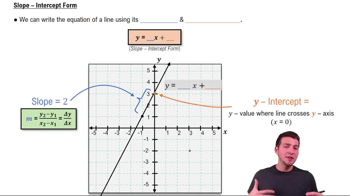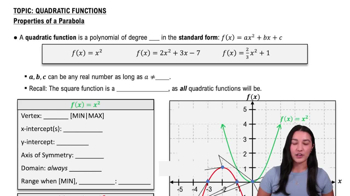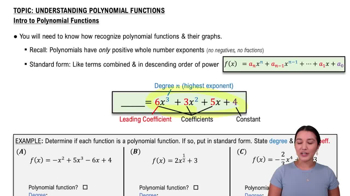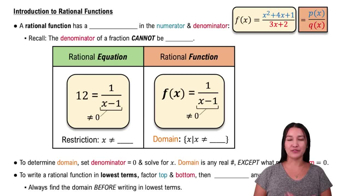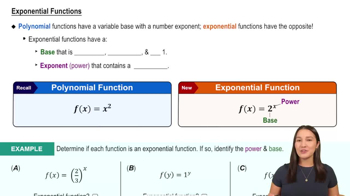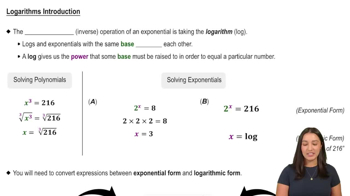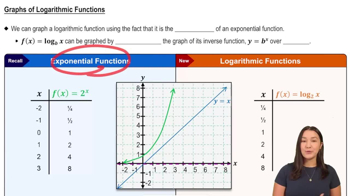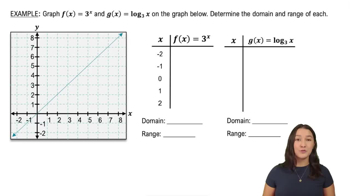Table of contents
- 0. Functions7h 52m
- Introduction to Functions16m
- Piecewise Functions10m
- Properties of Functions9m
- Common Functions1h 8m
- Transformations5m
- Combining Functions27m
- Exponent rules32m
- Exponential Functions28m
- Logarithmic Functions24m
- Properties of Logarithms34m
- Exponential & Logarithmic Equations35m
- Introduction to Trigonometric Functions38m
- Graphs of Trigonometric Functions44m
- Trigonometric Identities47m
- Inverse Trigonometric Functions48m
- 1. Limits and Continuity2h 2m
- 2. Intro to Derivatives1h 33m
- 3. Techniques of Differentiation3h 18m
- 4. Applications of Derivatives2h 38m
- 5. Graphical Applications of Derivatives6h 2m
- 6. Derivatives of Inverse, Exponential, & Logarithmic Functions2h 37m
- 7. Antiderivatives & Indefinite Integrals1h 26m
- 8. Definite Integrals4h 44m
- 9. Graphical Applications of Integrals2h 27m
- 10. Physics Applications of Integrals 2h 22m
0. Functions
Common Functions
Problem 25
Textbook Question
Evaluating trigonometric functions Without using a calculator, evaluate the following expressions or state that the quantity is undefined.
cot (-17π/3)
 Verified step by step guidance
Verified step by step guidance1
Step 1: Understand the cotangent function. The cotangent function, \( \cot(\theta) \), is defined as \( \frac{\cos(\theta)}{\sin(\theta)} \).
Step 2: Simplify the angle. The angle \( -\frac{17\pi}{3} \) is not within the standard range \( [0, 2\pi) \). To simplify, add \( 2\pi \) repeatedly until the angle is within this range.
Step 3: Calculate the equivalent positive angle. Since \( 2\pi = \frac{6\pi}{3} \), add \( \frac{6\pi}{3} \) to \( -\frac{17\pi}{3} \) multiple times until the angle is positive and within \( [0, 2\pi) \).
Step 4: Determine the reference angle. Once the angle is simplified, find the reference angle, which is the acute angle the terminal side makes with the x-axis.
Step 5: Evaluate \( \cot(\theta) \) using the reference angle. Use known values of sine and cosine for the reference angle to find \( \cot(\theta) = \frac{\cos(\theta)}{\sin(\theta)} \).
 Verified video answer for a similar problem:
Verified video answer for a similar problem:This video solution was recommended by our tutors as helpful for the problem above
Video duration:
4mPlay a video:
Was this helpful?
Key Concepts
Here are the essential concepts you must grasp in order to answer the question correctly.
Cotangent Function
The cotangent function, denoted as cot(x), is the reciprocal of the tangent function. It is defined as cot(x) = cos(x)/sin(x). Understanding cotangent is essential for evaluating expressions involving this function, especially in trigonometric identities and transformations.
Recommended video:
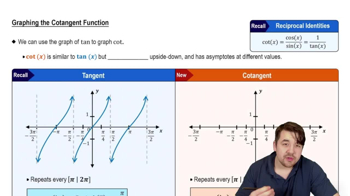
Introduction to Cotangent Graph
Periodic Properties of Trigonometric Functions
Trigonometric functions are periodic, meaning they repeat their values in regular intervals. For example, the cotangent function has a period of π, which means cot(x) = cot(x + nπ) for any integer n. This property allows us to simplify angles that are outside the standard range of 0 to 2π.
Recommended video:

Properties of Functions
Angle Reduction
Angle reduction involves converting a given angle into an equivalent angle within a standard range, typically between 0 and 2π. For cot(-17π/3), we can add multiples of 2π to find a coterminal angle that is easier to evaluate, facilitating the calculation of the cotangent value.
Recommended video:
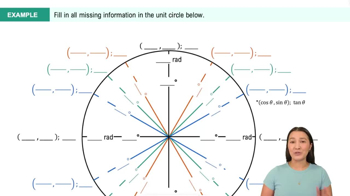
Trig Values in Quadrants II, III, & IV Example 2

 5:57m
5:57mWatch next
Master Graphs of Common Functions with a bite sized video explanation from Nick
Start learningRelated Videos
Related Practice



